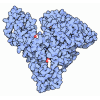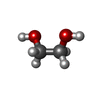Entry Database : PDB / ID : 6e3gTitle Structure of RORgt in complex with a novel agonist. Nuclear receptor ROR-gamma co-activator peptide Keywords / / / / Function / homology Function Domain/homology Component
/ / / / / / / / / / / / / / / / / / / / / / / / / / / / / / / / / / / / / / / / / / / / / / / / / / / / / / / / / / / / / / / / / / / / / / / / / / / / / / / / / / / / / / / / / / / / / / / / / / / / / / / / / / / / / / / / / / / / / / / / / / / / / / / / / / / / / / / / / / / / / / / / / / / / / / / / / / Biological species Homo sapiens (human)Method / / Resolution : 2.1 Å Authors Skene, R.J. / Hoffman, I. Journal : J.Med.Chem. / Year : 2019Title: Design, Synthesis, and Biological Evaluation of Retinoic Acid-Related Orphan Receptor gamma t (ROR gamma t) Agonist Structure-Based Functionality Switching Approach from In House ROR gamma t ... Title : Design, Synthesis, and Biological Evaluation of Retinoic Acid-Related Orphan Receptor gamma t (ROR gamma t) Agonist Structure-Based Functionality Switching Approach from In House ROR gamma t Inverse Agonist to ROR gamma t Agonist.Authors: Yukawa, T. / Nara, Y. / Kono, M. / Sato, A. / Oda, T. / Takagi, T. / Sato, T. / Banno, Y. / Taya, N. / Imada, T. / Shiokawa, Z. / Negoro, N. / Kawamoto, T. / Koyama, R. / Uchiyama, N. / ... Authors : Yukawa, T. / Nara, Y. / Kono, M. / Sato, A. / Oda, T. / Takagi, T. / Sato, T. / Banno, Y. / Taya, N. / Imada, T. / Shiokawa, Z. / Negoro, N. / Kawamoto, T. / Koyama, R. / Uchiyama, N. / Skene, R. / Hoffman, I. / Chen, C.H. / Sang, B. / Snell, G. / Katsuyama, R. / Yamamoto, S. / Shirai, J. History Deposition Jul 13, 2018 Deposition site / Processing site Revision 1.0 Jun 12, 2019 Provider / Type Revision 1.1 Mar 13, 2024 Group / Database references / Category / chem_comp_bond / database_2Item / _database_2.pdbx_database_accession
Show all Show less
 Open data
Open data Basic information
Basic information Components
Components Keywords
Keywords Function and homology information
Function and homology information Homo sapiens (human)
Homo sapiens (human) X-RAY DIFFRACTION /
X-RAY DIFFRACTION /  SYNCHROTRON / Resolution: 2.1 Å
SYNCHROTRON / Resolution: 2.1 Å  Authors
Authors Citation
Citation Journal: J.Med.Chem. / Year: 2019
Journal: J.Med.Chem. / Year: 2019 Structure visualization
Structure visualization Molmil
Molmil Jmol/JSmol
Jmol/JSmol Downloads & links
Downloads & links Download
Download 6e3g.cif.gz
6e3g.cif.gz PDBx/mmCIF format
PDBx/mmCIF format pdb6e3g.ent.gz
pdb6e3g.ent.gz PDB format
PDB format 6e3g.json.gz
6e3g.json.gz PDBx/mmJSON format
PDBx/mmJSON format Other downloads
Other downloads 6e3g_validation.pdf.gz
6e3g_validation.pdf.gz wwPDB validaton report
wwPDB validaton report 6e3g_full_validation.pdf.gz
6e3g_full_validation.pdf.gz 6e3g_validation.xml.gz
6e3g_validation.xml.gz 6e3g_validation.cif.gz
6e3g_validation.cif.gz https://data.pdbj.org/pub/pdb/validation_reports/e3/6e3g
https://data.pdbj.org/pub/pdb/validation_reports/e3/6e3g ftp://data.pdbj.org/pub/pdb/validation_reports/e3/6e3g
ftp://data.pdbj.org/pub/pdb/validation_reports/e3/6e3g Links
Links Assembly
Assembly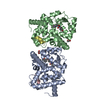


 Components
Components Homo sapiens (human) / Gene: RORC, NR1F3, RORG, RZRG / Production host:
Homo sapiens (human) / Gene: RORC, NR1F3, RORG, RZRG / Production host: 
 Homo sapiens (human) / Production host: synthetic construct (others) / References: UniProt: Q15788*PLUS
Homo sapiens (human) / Production host: synthetic construct (others) / References: UniProt: Q15788*PLUS X-RAY DIFFRACTION / Number of used crystals: 1
X-RAY DIFFRACTION / Number of used crystals: 1  Sample preparation
Sample preparation SYNCHROTRON / Site:
SYNCHROTRON / Site:  ALS
ALS  / Beamline: 5.0.3 / Wavelength: 0.97 Å
/ Beamline: 5.0.3 / Wavelength: 0.97 Å Processing
Processing Movie
Movie Controller
Controller



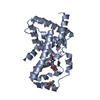

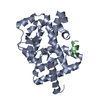

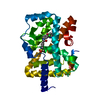


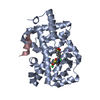
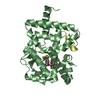
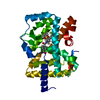
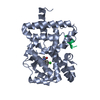
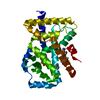


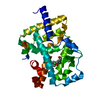

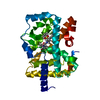
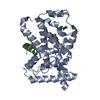
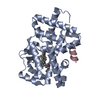
 PDBj
PDBj






